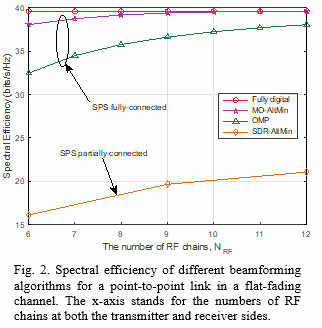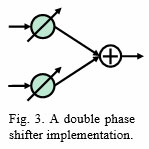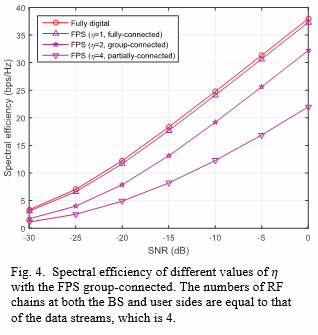
Contributed by Dr. Xianghao Yu and Dr. Jun Zhang and based on the original article published in the IEEE Open J. Commun. Soc., vol. 1, pp. 77-91, 2020, available in IEEEXplore®, and an SPS webinar available in the SPS Resource Center.
The upcoming 5G network needs to achieve substantially larger link capacity and ultra-low latency to support emerging mobile applications. While conventional techniques have reached their limits, uplifting the carrier frequency to the millimeter-wave (mm-wave) band stands out as an effective approach to further boost the network capacity, as it provides orders of magnitude greater spectrum than current cellular bands. Thus, mm-wave communication is becoming synonymous with 5G. Large-scale antenna arrays are needed to fully exploit the performance gains of mm-wave communications, which brings formidable challenges to algorithm design and hardware implementation. Conventional fully digital beamforming techniques are inapplicable, as they demand a separate radio frequency (RF) chain for each antenna element. Hybrid beamforming is recently proposed as a cost-effective alternative, which requires a small number of RF chains and thus can significantly reduce hardware cost and power consumption, c.f. Fig. 1.

Fig. 1. Hybrid beamforming in a general multiuser multicarrier system.
Nevertheless, the successful implementation of hybrid beamforming faces a few key challenges. Due to the unit-modulus constraint for the analog component, hybrid beamforming problems are inherently nonconvex and may induce unaffordable computational complexity. It is of critical importance to further reduce the hardware complexity of hybrid beamforming structures, as mm-wave components are costly and power hungry. Meanwhile, the reduced hardware complexity may introduce substantial performance degradation compared with the fully digital beamforming. Thus, the design of hybrid beamforming differs fundamentally from that of the fully digital one. This article introduces recent developments in this active area, including effective hardware structures and beamforming algorithms. A holistic approach is taken, emphasizing three decisive aspects: 1) hardware efficiency (HE), i.e., the required hardware components; 2) computational efficiency (CE) of the associated beamforming algorithm; and 3) achievable spectral efficiency (SE). Through systematic comparison, the interplay and tradeoff among the three design aspects will be demonstrated, and promising candidates for hybrid beamforming in 5G mm-wave systems will be identified.
Approach the fully digital – High spectral efficiency via nonconvex optimization
For hybrid beamforming, the analog network in the RF domain is the differentiating hardware block compared to the fully digital beamforming, whose structure is primarily determined by two factors: the mapping strategy and hardware implementation. The mapping strategy determines how the RF chains and antenna elements are connected, while the hardware implementation specifies the adopted hardware components and the way each RF chain-antenna pair is connected.

A classic analog network structure is to adopt a single phase shifter (SPS) to connect each RF chain with all antenna elements, referred to as the SPS fully connected structure. This structure can achieve the performance of the fully digital beamforming when the number of RF chains is at least twice that of data streams. For more general cases, to tackle the nonconvex unit modulus constraints, orthogonal matching pursuit (OMP) is a widely used algorithm [1]. Then, a manifold optimization based alternating minimization (MO-AltMin) algorithm was proposed, which significantly outperforms the OMP one [2]. As can be observed in Fig. 2, with the MO-AltMin algorithm, the fully connected structure can approach the performance of the fully digital beamforming with only a small number of RF chains. However, this design approach suffers a prohibitively high computational complexity.
The other analog network widely considered in the literature is called the SPS partially connected structure, where each RF chain is connected to only a part of antenna elements via a phase shifter. The AltMin principle can also be leveraged to design such a structure, with closed-form solutions in each iteration. Therefore, the SPS partially connected structure significantly reduces the number of phase shifters, yet shown to be with much degraded performance compared with the SPS fully connected one [2].
Boost computational efficiency – A convex relaxation approach
 Note that the unit modulus constraint is the main difficulty in hybrid beamforming design. One may relax this nonconvex constraint with its convex counterpart for tractable optimization. With this relaxation, for the fully connected structure, the hybrid beamforming problem turns out to be a low rank matrix approximation problem, which has been well studied and is with a closed form solution. On the other hand, the hybrid beamforming design for the partially connected structure is identified as an eigenvalue problem [3]. Thus, this approach brings great advantages in computational efficiency. If it is affordable to double the number of phase shifters, the relaxed beamformer can be implemented in practice. In particular, for each connection from an RF chain to one of its connected antenna elements, two unique phase shifters are summed up to compose the analog beamforming gain, referred to as the double phase shifter (DPS) implementation, as shown in Fig. 3. In other words, it provides a hardware structure for which the optimal hybrid beamformer can be efficiently found.
Note that the unit modulus constraint is the main difficulty in hybrid beamforming design. One may relax this nonconvex constraint with its convex counterpart for tractable optimization. With this relaxation, for the fully connected structure, the hybrid beamforming problem turns out to be a low rank matrix approximation problem, which has been well studied and is with a closed form solution. On the other hand, the hybrid beamforming design for the partially connected structure is identified as an eigenvalue problem [3]. Thus, this approach brings great advantages in computational efficiency. If it is affordable to double the number of phase shifters, the relaxed beamformer can be implemented in practice. In particular, for each connection from an RF chain to one of its connected antenna elements, two unique phase shifters are summed up to compose the analog beamforming gain, referred to as the double phase shifter (DPS) implementation, as shown in Fig. 3. In other words, it provides a hardware structure for which the optimal hybrid beamformer can be efficiently found.
Fight for hardware efficiency – How many phase shifters are needed?

A recently proposed hybrid beamforming structure was introduced in [4], which achieves higher hardware efficiency than existing ones and also offers a flexible tradeoff between spectral efficiency and hardware efficiency. First, a fixed phase shifter (FPS) implementation was proposed, which only requires a small number of phase shifters with quantized and fixed phases, and thus significantly reduces the cost and power consumption. To enhance spectral efficiency, a switch network was put forward to provide dynamic connections from phase shifters to antennas. To further reduce the hardware complexity, a group connected mapping strategy was introduced to reduce the number of switches [5]. This mapping strategy is a generalization of the conventional fully connected and partially connected mappings. Efficient algorithms for dynamic switch network design were then presented in [4]. It is shown in Fig. 4 that, remarkably, the FPS fully connected structure performs closely to the fully digital one, though with much fewer phase shifters, which makes the FPS implementation very attractive for practical deployment.
The hybrid beamforming structures and algorithms discussed in this article can also be applied for investigating other promising research directions such as the joint design with CSI acquisition and uncertainty, comparison between different antenna configurations, and hybrid beamforming for THz communications.
Note: All the figures appear in: J. Zhang, X. Yu and K. B. Letaief, “Hybrid Beamforming for 5G and Beyond Millimeter-Wave Systems: A Holistic View,” IEEE Open J. Commun. Soc., vol. 1, pp. 77-91, 2020, doi: 10.1109/OJCOMS.2019.2959595.
References:
[1] O. El Ayach, S. Rajagopal, S. Abu-Surra, Z. Pi, and R. W. Heath, “Spatially sparse precoding in millimeter wave MIMO systems,” IEEE Trans. Wireless Commun., vol. 13, no. 3, pp. 1499–1513, Mar. 2014, doi: 10.1109/TWC.2014.011714.130846.
[2] X. Yu, J.-C. Shen, J. Zhang, and K. B. Letaief, “Alternating minimization algorithms for hybrid precoding in millimeter wave MIMO systems,” IEEE J. Sel. Topics Signal Process., vol. 10, no. 3, pp. 485-500, Apr. 2016, doi: 10.1109/JSTSP.2016.2523903 (2018 IEEE Signal Processing Society Young Author Best Paper Award).
[3] X. Yu, J. Zhang, and K. B. Letaief, “Doubling phase shifters for efficient hybrid precoding in millimeter-wave multiuser OFDM systems,” J. Commun. Inf. Netw., vol. 4, no. 2, pp. 51-67, July 2019.
[4] X. Yu, J. Zhang, and K. B. Letaief, “Hybrid precoding in millimeter wave systems: How many phase shifters are needed?” in Proc. IEEE Global Commun. Conf. (GLOBECOM), Singapore, Dec. 2017, pp. 1-6, doi: 10.1109/GLOCOM.2017.8254864 (Best Paper Award).
[5] X. Yu, J. Zhang, and K. B. Letaief, “A hardware-efficient analog network structure for hybrid precoding in millimeter wave systems,” IEEE J. Sel. Topics Signal Process., vol. 12, no. 2, pp. 282-297, May 2018, doi: 10.1109/JSTSP.2018.2814009.
